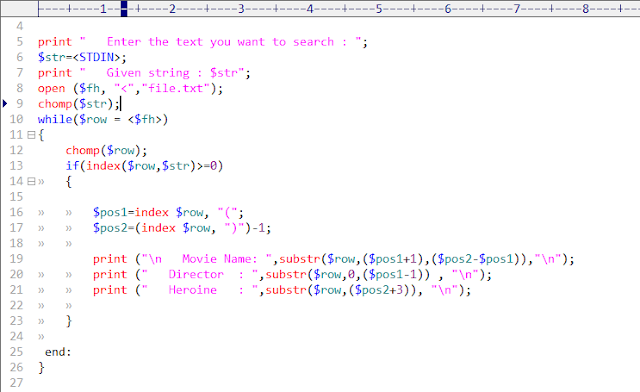What is Perl?
Perl is
a general purpose programming language originally developed for text
manipulation. Now it is also used for Web development, network programming, GUI
development and more.
Perl is
an acronym for Practical Extracted and
Report Language. Perl works with XML, HTML and other mark-up languages. Perl interfaces with external C/C++
libraries.
Perl is Interpreted
Perl is
interpreted language, which means that your code can be run as is without a
compilation stage.
Traditional
compilers convert programs into machine language. When you run a perl program,
it’s first compiled into a byte code, which is then converted to machine
instructions.
Perl Environment Setup
Step1:
Check whether perl already installed into your system.
Step2: Goto http://strawberryperl.com/ to download if it is not installed.
Step3: Install the downloaded file.
Step4: Make sure that installation completed successfully.
Writing a First Perl Program
Step1: Goto the folder where perl software was installed.
Step2: Create a document with extension as .pl.
Creating Variables
Perl
variables do not have to be explicitly declared to reserve memory space. The
declaration happens automatically when you assign a value to a variable.
‘$’ sign
is used to declare a variable.
Example:
Output:
Array Variables
Array variable is prefixed with '@' operator and populated using parenthesis or qw operator.
Example:
Example:
2. if..else() statement:
Output:
Looping Statements
1. for() loop:
Output:
2. while() loop:
Output:
3. do..while() loop:
Output:
4. foreach() loop:
String Manipulations
1. Concatination:
Output:
2. Converting to Uppercase and Lowercase:
Output:
2. Finding a Substring:
3. Index():
This function position of -1 if no match found or else returns position of matching string.
4. Split():
5. Join():
Interacting to File Systems
Example1: Opening and writing to a file.
Example2: Finding and replacing the text on file.
Example2: Reading and displaying text from a file.
Input file and Output:


































0 comments: